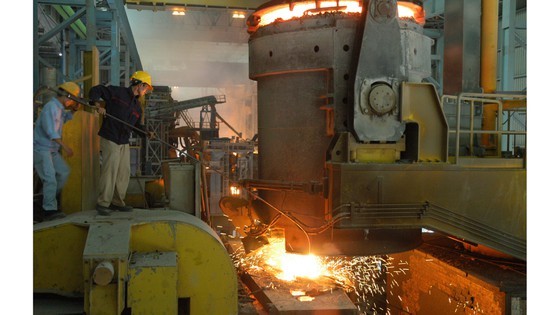
Great potentials
Analysis from environmental experts shows that steel production and solid waste treatment can immediately be exploited as the revenue source for the carbon credit trading market. As for the steel industry, there are currently over 300 small and medium-sized enterprises producing cast iron and steel.
This industry is also maintaining a high growth rate, estimated at 18 percent per year for production materials and 20 percent for consumption. However, the priority to invest and develop this industry in a long time of lacking strict control on production technology has made gas emissions of this industry larger and larger, seriously affecting the quality of the environment.
A survey by the Department of Energy Saving under the Ministry of Industry and Trade shows that, on average, to produce 10 million tons of steel, factories in Vietnam emit about 21 million tons of carbon dioxide (CO2) into the environment. Emissions of the whole steel industry are estimated at 122.5 million tons of CO2 in 2025 and increase to about 133 million tons of CO2 in 2030, accounting for 17 percent of the total national emissions. The reason is that most steel factories are dependent on fossil fuels or electricity.
As for the field of household solid waste treatment, the report of the Ministry of Natural Resources and Environment (MoNRE) states that, on average, the amount of solid waste generated nationwide is about 12 million tons each year. Up to 90 percent of total solid waste must be treated by landfill technology. Ho Chi Minh City is the place with the highest amount of household solid waste generated in the country, estimated at nearly 3.5 million tons per year, and 90 percent of this total amount of waste is being treated by burying.
The inventory results of greenhouse gas for solid waste treatment activities carried out by the Ministry of Construction show that the amount of greenhouse gas emissions generated from landfills had increased from 6.5 million tons of CO2 in 2014 to 8.1 million tons in 2017 and is expected to exceed 10 million tons of CO2 in 2020.
Cutting greenhouse gas emissions from the two above fields not only reduces the risk of environmental pollution but also becomes a foundation for Vietnam to complete the mechanism of establishing a carbon credit trading market in the coming time.
Mr. Nguyen Tuan Quang, Deputy Director of the Department of Climate Change under the MoNRE, said that with the steel industry, just by replacing fossil fuels with renewable energy sources, it can reduce 13.5 percent of total CO2 emissions. This ratio will also decrease by 25 percent if using biomass coal. Especially, if using renewable electricity in steelmaking technology with electric arc furnaces, the probability of reducing gas emissions will be up to 70 percent. As for the field of solid waste treatment, it is estimated that using methane gas collected from solid waste deposited in landfills can help reduce up to 60 percent of emissions generated during the landfilling. However, if the waste is sorted in combination with the application of waste-to-energy incineration technology, the amount of generated emissions will be reduced by up to 90 percent.
Lack of facilities
The effective implementation of greenhouse gas emission reduction in the two industries is also the way that Vietnam implements the United Nations Framework Convention on climate change. Accordingly, the Government has committed to reducing gas emissions by 9 percent in September this year compared to the usual scenario with domestic resources and by 27 percent with international support.
However, according to many enterprises, to establish a complete carbon credit trading market, lots of infrastructures still need completing. First, we have to price carbon. It is a necessary and sufficient condition for investors and enterprises to buy and sell carbon credits, opening up new directions in environmental protection, and requiring production facilities to invest in reducing gas emissions or paying money for carbon credits.
On the other hand, it is necessary to build and promulgate the greenhouse gas inventory system and greenhouse gas emission monitoring and estimating system at the national, regional, sectoral, sub-sector, and manufacturing establishment levels accurately and transparently following international requirements and standards. Next, it is necessary to develop and promulgate a set of criteria to determine the greenhouse gas emission limit for each industry, sub-sector, and manufacturing establishment.
In another perspective, Mr. Huynh Minh Nhut, Head of the Ho Chi Minh City Urban Environment Company Limited, said that it is essential to speed up the construction of infrastructure for the ecosystem of waste recycling. For instance, in HCMC – the place accounts for 74 percent of landfill waste nationwide, the classification of solid waste at source has not been conducted synchronously. This situation leads to the risk of a lack of input materials for solid waste treatment plants using waste-to-energy incineration technology approved by the People's Committee of HCMC.
Lately, the company has cooperated with the plastic packaging recycling coalition to invest in building a network to collect and treat recyclable waste from the program of sorting household solid waste at the source. It will be the foundation for building the model of waste treatment and recycling center, contributing to increase the operational efficiency of the waste treatment plant into clean electricity and minimize the amount of gas emissions from waste.
























